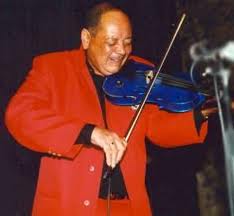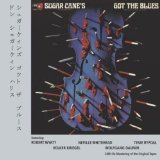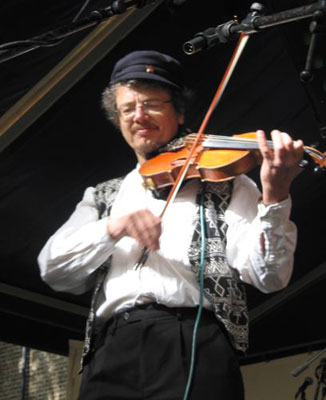
MENU TO FIDDLE STYLES:
Don Sugarcane Harris
Don “Sugarcane” Harris, from Pasadena, California was born in 1938, and by his teens was playing R&B guitar and violin with Dewey Terry under the name Don and Dewey. In the 60’s they separated, and Harris began to concentrate on electric blues violin. He made many appearances as a sideman, with artists such as John Mayall and the Bluesbreakers, Johnny Otis, John Lee Hooker and Little Richard. He is probably best remembered, though, for his work with Frank Zappa in the 1970’s, notably the grinding, take-no-prisoners rocking blues “Weasels ripped my Flesh”. Here he makes the most of his raw, shredding sound, frequent “harmonica” trills, tremelo and double stops. His playing can be fast and fluent, but is most effective on slow numbers, where his distinctive thin tone and shaky vibrato come across as vulnerable and sensitive.
One of his lesser known but most interesting recordings was the “New Violin Summit” recorded in Germany in 1971, alongside Jazz violinists Jean Luc Ponty (veteran of the original Violin Summit), Michael Urbaniak from Poland, and the Austrian gypsy jazz fiddler Nipso Brantner.
He is widely regarded as one of the 20th Century's gretest natural talents in his field:
David Lindley referred to Sugar Cane as a “force of nature”, while Dave Arbus, of East of Eden, said “there are quite a few violinist on the scene, but Sugar Cane is the only true rock fiddler. His feeling, his phrasing, his timing, unreachable!”
Guitarist Randy Resnick, who played with Don in the band Pure Food and Drug Act (PFDA)in the 1970’s had this to say; “I never got chills in any other band like the ones I got when Don took off alone in a cadenza or when he and Paul did violin-drums duets. It was tribal, it was primitive and it was real music with all the faults that make us human. Don had a swing to his playing, a groove, a soulfulness that you don't hear anywhere else. No one plays with such gut-wrenching rawness, because musicians are trained to play "better".
Sugar Cane’s got the blues (Review)
No one would ever accuse Sugar Cane Harris of being smooth and polished in his playing. Compared to contemporaries from the 70’s American jazz/rock/fusion scene such as Jerry Goodman or Jean-Luc Ponty, his playing is rough and unsophisticated. Yet Sugar Cane is the genuine article; a blues/rock violinist whos playing is untroubled by classical veneer and technique. He plays as if he had learned the blues sitting at his Gradpappy’s knee, as he probably did. He is best known for his work with Frank Zappa, but in that bizarre hybrid setting it is difficult to assess what one is really hearing from Sugar Cane. On this cd, a live recording from the 1971 Berlin Jazz Festival, we get a much better idea of what he’s all about. Backed by guitar, piano, bass, and the great Robert Wyatt on drums, he gives us four extended numbers.
First up is Liz Pineapple Wonderful, which opens with some energetic and fairly unique rhythmic pizzicato chopping, with the violin held guitar style, which Sugarcane then sings over. He takes the first solo, blazing in on the minor blues scale, pouring out a seemingly inexhaustible stream of licks. He doesn’t just confine himself to the blues scale, but plays some interesting extensions (especially the 9th). He reverts to rhythmic strumming behind the guitar solo, before finishing with an extended blues swirl. These were the days of chord rationing, and a single A is frugally stretched out over around 8 minutes.
The title track, Sugar Cane’s got the Blues, opens with a slow rubato unaccompanied violin swirl, demonstrating just what you can do if you learn the minor blues pattern so well that you can play it at full speed without any effort. This leads into some unusual and thoughtful double stop work, some tremello and sul ponticello, and then around 10 minutes of rambling guitar and piano solos, before it’s back to the fiddle and some fine unaccompanied shredding. The audience seemed delighted, but if you’re looking for anything resembling structure or composition this number is not for you.
We return to some semblance of order with track3, a medium tempo latin groove which turns out to be Horace Silver’s Song for my Father. Here we get some excellent violin soloing over the four-chord descending sequence, and a reminder that on this kind of number you can solo freely without any reference to the chord changes, and repeat a simple lick as many times as you like; so long as you stick with the blues scale it’s going to sound great.
The fourth and final track (Where’s my sunshine) is the only actual blues (ie 12-bar) on the album. It opens with more pizzicato strumming behind Sugar Cane’s singing, then a long violin solo where he eventually uses a wah pedal. It wraps up with a typical ending- an extended rubato violin swirl up and down the blues scale, with some more sul ponticello for good measure. All in all, this performance was pretty much a free-for all jam, but it gives us an excellent measure of what Sugar Cane Harris can do when given free rein. There’s no one quite like him.
Return to fiddlingaround.co.uk homepage
Chris Haigh is a London-based fiddle player who specialises in Klezmer, gypsy and East European styles. He plays with a trio, Klezmania, doing lots of Jewish weddings and Bar Mitzvahs; this band does a mixture of traditional Klezmer and Israeli tunes along with some jazz improvisation. Tziganarama is Chris's own trio, playing a wide range of Jewish, Russian, Balkan and gypsy music, whilst The Kremlinaires is Chris's wacky 7-piece Soviet Swing band.
Chris sometimes plays solo or as a duo with accordion, going "around the tables" at a dinner.
He gives workshops on klezmer, gypsy and other east european fiddle styles, demonstrating techniques and ornamentation, describing the different tunes types and scales.
He writes original klezmer melodies; his tune "Klezmania" was used on a worldwide TV ad for Nike!




